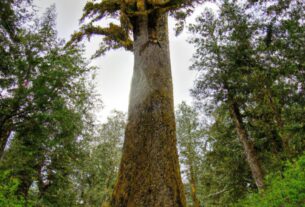Devils Tower, a majestic geological marvel standing tall over the Black Hills of Wyoming, captures the imagination of thousands of visitors each year. Beyond its sheer beauty lies a captivating history and culture that make Devils Tower all the more intriguing.
The Enigmatic History of Devils Tower
Unraveling Geologic Formation
The Devils Tower, estimated to have formed around 50 million years ago during the Eocene epoch, is an immense igneous intrusion. Composed of phonolite porphyry, a volcanic rock rich in feldspar and quartz, the tower resulted from a volcanic eruption that forced magma to the surface and solidified into its distinctive columnar shape.
The hexagonal columns, ranging from inches to several feet in diameter, were formed as the lava cooled and contracted, causing cracks that split the rock into polygonal columns.
Encounters with Early Humans
Devils Tower has witnessed human presence for over 10,000 years, with evidence of Native American occupation in its surrounding area. It served as a significant landmark and a site for various tribal practices, including vision quests, healing rituals, and ceremonies.
In the late 1800s, European settlers began exploring the region, establishing a military post nearby. It was Colonel Richard Dodge who named the tower Devils Tower in 1875. Since then, it has become a popular destination for tourists and climbers alike.
Sacredness in Native American History and Spirituality
Devils Tower holds profound spiritual significance for Native Americans. It is regarded as a sacred site by many tribes, brimming with mystical power. Various legends and stories are intertwined with the tower, illuminating its cultural importance.
The Lakota people, for example, perceive Devils Tower as a potent place of power, a gateway to the spirit world. They believe the tower is inhabited by supernatural beings and that it possesses transformative and healing qualities for those who visit.
The Legends of Seven Sisters
The Story Unveiled
One of the most well-known tales connected to Devils Tower is that of the Seven Sisters. This legend, with its variations across different tribes and storytellers, revolves around seven girls who found themselves pursued by a bear. Seeking refuge atop a rock, the rock ascended higher and higher, lifting the girls to the sky, where they became the constellation known as the Pleiades. The bear transformed into the constellation Ursa Major.
Unveiling Symbolism of Sacrifice and Transformation
The legend of the Seven Sisters reaches far beyond a simple fairy tale. It carries layers of profound meaning and symbolism that shed light on the values and beliefs of Native American culture. Sacrifice emerges as a key theme, with the girls in the story risking their lives to save one another and attain the safety of the rock. This act embodies the significance of community and kinship within Native American society.
Transformation is another essential motif in the legend. The ascending rock symbolizes a link between the earthly and the spiritual realms. The girls’ transformation into celestial beings reflects the belief that humans can transcend their earthly limitations and encompass a more extensive cosmic order.
Exploring Native American Mythology
The legend of the Seven Sisters is but a glimpse into the intricate tapestry of Native American mythology. Countless other stories and legends share similar themes, highlighting nature’s importance, the power of animals, and the influence of supernatural forces. Delving into these myths and stories offers a profound appreciation for the complexity and diversity of Native American culture.
Insights and Controversies Surrounding the Legend
The Devils Tower legend has sparked diverse interpretations, unveiling distinct facets of Native American culture and history. Understanding these interpretations is crucial in appreciating the legend’s significance.
Cultural Significance and Lessons
The legend holds immense cultural and historical importance for Native American tribes. The tower stands as a sacred site, embodying great spiritual power. The story of the Seven Sisters, for instance, serves as a reminder of the value of community, perseverance, and sacrifice. It emphasizes the interconnectedness of all things in the natural world, illustrating the role of humans within a larger cosmic order.
The legend also conveys essential moral lessons and values. Respect for nature and the environment, courage, wisdom, and humility in the face of adversity, are just a few examples emphasized throughout various interpretations.
Popular Culture Influences
The Devils Tower legend profoundly impacts popular culture, featuring in movies, books, and TV shows as a symbol of mystery, wonder, and spiritualism. Films like “Close Encounters of the Third Kind” have made the tower an iconic and central element within their plots.
Inspiring countless artists and writers, the legend serves as a wellspring of creativity. Some explore its cultural and historical significance, while others focus on its metaphysical and spiritual dimensions.
Controversies and Debates
Like any legend or myth, the interpretation of the Devils Tower legend remains a subject of debate and controversy. Critics argue that the legend has been romanticized or appropriated by non-Native Americans for their own purposes. Others claim that it has undergone distortion and misinterpretation over time, leading to cultural misunderstandings and misrepresentations.
Despite these controversies, the legend endures as a testament to the richness and diversity of Native American culture. It reminds us of the profound heritage of the tribes that have resided in the region for thousands of years, emphasizing the importance of preserving their traditions and legacy.
Exploring Devils Tower: Practical Tips
Overview of the Park and its Offerings
Devils Tower National Monument, enveloping 1,347 acres, beckons travelers to northeastern Wyoming, a mere hour’s drive from Gillette. The park encompasses not only the imposing tower but also hiking trails, picnic areas, and a visitor center.
Operating daily from 9 a.m. to 5 p.m. (extended hours in summer), the visitor center presents interactive exhibits, a gift shop, and a bookstore. Knowledgeable rangers are readily available to answer inquiries and provide insights into the park’s geology, history, and culture.
Several hiking trails cater to different abilities. The Tower Trail, a paved 1.3-mile loop encircling the tower’s base, treats visitors to breathtaking views of its unique rock formations and wildlife. Meanwhile, the Red Beds Trail, a 3.6-mile trek, guides hikers through the surrounding prairie, offering panoramic vistas of the Black Hills.
Respectful Visits to the Tower
As Devils Tower holds profound sacred significance for many Native American tribes, visitors are encouraged to approach the park with utmost respect and reverence. Here are essential tips to keep in mind:
- Avoid climbing the tower during June, a month of spiritual importance for many Native Americans.
- Be considerate of any ongoing religious ceremonies or rituals and refrain from disrupting them.
- Do not remove rocks or artifacts from the park.
- Avoid touching or climbing on any rock formations or trees, as they may hold sacred significance.
- Respect the wildlife and stay on designated trails.
Cultural Sensitivity and Awareness on Native American Lands
Devils Tower is merely one of numerous sacred sites throughout the United States that hold paramount importance to Native American culture. When visiting such sites, it is crucial to become aware of the history, traditions, and beliefs of the local tribes and to demonstrate respect for their culture.
Through these visits, we have the opportunity to learn from Native American culture, integrating their wisdom into our daily lives. We develop a deeper appreciation for nature, practice mindfulness and gratitude, and foster a sense of community and connection.
Embracing Devils Tower’s Cultural Heritage
In conclusion, the Devils Tower legend serves as a powerful testament to the vibrant and profound culture of Native American tribes. It encapsulates their spiritual beliefs, values, and traditions, providing us with a unique lens through which to view the world.
As visitors to Devils Tower, it is our responsibility to respect and honor the sacredness of the site. This involves mindful actions, adherence to park regulations, and a deep dive into the history and culture of the tribes who consider the tower their ancestral home.
Furthermore, by immersing ourselves in the legend of the Seven Sisters, we gain a profound appreciation for the wisdom and beauty of Native American storytelling. It grants us a fresh perspective, one that emphasizes harmony, balance, and interconnectedness.
At TooLacks, we are committed to promoting cultural awareness and understanding. By sharing stories such as the Devils Tower legend, we bridge the gaps between cultures, fostering an inclusive society.
Join us on this enlightening journey of discovery and exploration. Together, let us celebrate the world’s diversity and learn from one another’s perspectives. Only through embracing our differences can we marvel at the beauty and richness of life.
For more information about TooLacks, click here.


